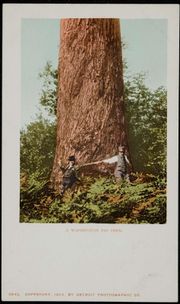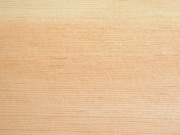Difference between revisions of "Douglas fir"
JMcGlinchey (talk | contribs) |
|||
| (8 intermediate revisions by 3 users not shown) | |||
| Line 1: | Line 1: | ||
| − | [[File: | + | [[File:Douglas Fir.jpg|thumb|Washington Fir tree on post card<br>MFA #2013.6386]] |
| − | |||
| − | |||
== Description == | == Description == | ||
| + | [[File:07_DouglasFir.jpg|thumb|Douglas Fir (''Pseudotsuga taxifolia'')]] | ||
| + | A tall, evergreen tree, ''Pseudotsuga menziesii'' (also called ''P. douglasii ''and ''P. taxifolia'') found at high elevations in the western part of North America. The Douglas fir has been called the greatest of all trees as it is the most used timber in the world. The oldest species of Douglas fir is estimated at 1300 years old. The coniferous tree averages over 100 feet in height and 10 feet in thickness. Record setting heights of 417 feet and girths 49 feet have been measured. The leaves are flat, soft, linear, 2-4 cm long and occur singly. Douglas firs produce a reddish-brown softwood that is durable and resistant to insects. It has a straight grain with a slightly uneven texture. Timber from the Douglas fir is used in home construction, telephone poles, bridges, millwork, fences, barrels, plywood, chipboard, and kraft paper pulp. The wood is moderately acidic containing some organic acids. The bark contains catechol type tannins that are used to produce pliable, light-color leathers. The bark also contains a hard glossy wax similar to carnauba wax. A turpentine-like resin exudes from the freshly cut wood. | ||
| − | + | [[File:douglas_firwg.jpg|thumb|Douglas fir (''Pseudotsuga menziesii'']] | |
| − | |||
== Synonyms and Related Terms == | == Synonyms and Related Terms == | ||
''Pseudotsuga menziesii; Pseudotsuga douglasii; Pseudotsuga taxifolia''; pin Douglas (Fr.); pin d'Oregon (Fr.); Douglastanne (Deut.); pino d'Oregon (It., Esp.); abeto de Douglas (Esp.); pseudotsuga (Port.); duglasia (It.); Douglas pine; Douglas spruce; Oregon fir; Oregon pine; red fir; red pine; Puget Sound pine; yellow fir | ''Pseudotsuga menziesii; Pseudotsuga douglasii; Pseudotsuga taxifolia''; pin Douglas (Fr.); pin d'Oregon (Fr.); Douglastanne (Deut.); pino d'Oregon (It., Esp.); abeto de Douglas (Esp.); pseudotsuga (Port.); duglasia (It.); Douglas pine; Douglas spruce; Oregon fir; Oregon pine; red fir; red pine; Puget Sound pine; yellow fir | ||
| − | + | == Risks == | |
| − | == | ||
| − | |||
| − | |||
| − | |||
| − | |||
| − | |||
| − | |||
| − | |||
| − | |||
| − | |||
| − | |||
| − | |||
| − | |||
| − | |||
| − | |||
| − | |||
Splinter wounds heal slowly and often become infected. | Splinter wounds heal slowly and often become infected. | ||
| + | == Physical and Chemical Properties == | ||
| − | == | + | * Color: Red-brown summerwood and softer, yellowish springwood. |
| + | * Rings:distinct. Pores:absent. | ||
| + | * Grain: distinct. | ||
| + | * Rays:obscure. Soft, lightweight, resin canals visible. | ||
| + | * Density = 31-42 ppcf | ||
| + | * Specific gravity = 0.50 | ||
| − | + | Paper fiber type: Using transmitted light microscopy, fibers are identified by the presence of spiral thickening and piceoid pits 2-4 across. Since this is an abrupt transition softwood, there is a marked difference between early and late wood fibers. Appearance with [[Graff "C" stain]]: pale pink, varies with pulping and bleaching. Average dimensions of fibers: length 3.9mm, width 35-45μm. Common pulping method: [[kraft process|kraft]] and [[sulfite process|sulfite]]. | |
== Additional Images == | == Additional Images == | ||
<gallery> | <gallery> | ||
File:Douglas fir 40x spirals.jpg|Douglas fir paper pulp stained with Graff "C" stain | File:Douglas fir 40x spirals.jpg|Douglas fir paper pulp stained with Graff "C" stain | ||
| + | File:Douglas fir 40x spirals4.jpg|Douglas fir paper pulp stained with Graff "C" stain | ||
</gallery> | </gallery> | ||
| − | == | + | ==Resources and Citations== |
| + | * Alden Identification Services, Microscopic Wood Identification: [https://wood-identification.com/wood-types/ Link] | ||
| + | |||
| + | * Schoch, W., Heller, I., Schweingruber, F.H., Kienast, F., 2004:[http://www.woodanatomy.ch/ Wood anatomy of central European Species]: Douglas Fir,Oregon Pine, [http://www.woodanatomy.ch/species.php?code=PSME Pseudotsuga menziesii (Mirb.) Franco] | ||
* G.S.Brady, ''Materials Handbook'', McGraw-Hill Book Co., New York, 1971 Comment: p. 274 | * G.S.Brady, ''Materials Handbook'', McGraw-Hill Book Co., New York, 1971 Comment: p. 274 | ||
| Line 45: | Line 38: | ||
* H.L.Edlin, ''What Wood is That?'', Viking Press, New York, 1969 | * H.L.Edlin, ''What Wood is That?'', Viking Press, New York, 1969 | ||
| − | * ''Encyclopedia Britannica'', http://www.britannica.com Comment: Douglas fir. Retrieved May 29, 2003 | + | * ''Encyclopedia Britannica'', http://www.britannica.com Comment: Douglas fir. Retrieved May 29, 2003. |
* ''Dictionary of Building Preservation'', Ward Bucher, ed., John Wiley & Sons, Inc., New York City, 1996 | * ''Dictionary of Building Preservation'', Ward Bucher, ed., John Wiley & Sons, Inc., New York City, 1996 | ||
| Line 55: | Line 48: | ||
* Michael McCann, ''Artist Beware'', Watson-Guptill Publications, New York City, 1979 | * Michael McCann, ''Artist Beware'', Watson-Guptill Publications, New York City, 1979 | ||
| − | * | + | * Western Pine Association, Portland, Oregon: air-dry weight = 34 pcf |
* Marja-Sisko Ilvessalo-Pfäffli. ''Fiber Atlas: Identification of Papermaking Fibers'' (Springer Series in Wood Science). Springer, 1995. | * Marja-Sisko Ilvessalo-Pfäffli. ''Fiber Atlas: Identification of Papermaking Fibers'' (Springer Series in Wood Science). Springer, 1995. | ||
Latest revision as of 14:40, 22 July 2022
Description
A tall, evergreen tree, Pseudotsuga menziesii (also called P. douglasii and P. taxifolia) found at high elevations in the western part of North America. The Douglas fir has been called the greatest of all trees as it is the most used timber in the world. The oldest species of Douglas fir is estimated at 1300 years old. The coniferous tree averages over 100 feet in height and 10 feet in thickness. Record setting heights of 417 feet and girths 49 feet have been measured. The leaves are flat, soft, linear, 2-4 cm long and occur singly. Douglas firs produce a reddish-brown softwood that is durable and resistant to insects. It has a straight grain with a slightly uneven texture. Timber from the Douglas fir is used in home construction, telephone poles, bridges, millwork, fences, barrels, plywood, chipboard, and kraft paper pulp. The wood is moderately acidic containing some organic acids. The bark contains catechol type tannins that are used to produce pliable, light-color leathers. The bark also contains a hard glossy wax similar to carnauba wax. A turpentine-like resin exudes from the freshly cut wood.
Synonyms and Related Terms
Pseudotsuga menziesii; Pseudotsuga douglasii; Pseudotsuga taxifolia; pin Douglas (Fr.); pin d'Oregon (Fr.); Douglastanne (Deut.); pino d'Oregon (It., Esp.); abeto de Douglas (Esp.); pseudotsuga (Port.); duglasia (It.); Douglas pine; Douglas spruce; Oregon fir; Oregon pine; red fir; red pine; Puget Sound pine; yellow fir
Risks
Splinter wounds heal slowly and often become infected.
Physical and Chemical Properties
- Color: Red-brown summerwood and softer, yellowish springwood.
- Rings:distinct. Pores:absent.
- Grain: distinct.
- Rays:obscure. Soft, lightweight, resin canals visible.
- Density = 31-42 ppcf
- Specific gravity = 0.50
Paper fiber type: Using transmitted light microscopy, fibers are identified by the presence of spiral thickening and piceoid pits 2-4 across. Since this is an abrupt transition softwood, there is a marked difference between early and late wood fibers. Appearance with Graff "C" stain: pale pink, varies with pulping and bleaching. Average dimensions of fibers: length 3.9mm, width 35-45μm. Common pulping method: kraft and sulfite.
Additional Images
Resources and Citations
- Alden Identification Services, Microscopic Wood Identification: Link
- Schoch, W., Heller, I., Schweingruber, F.H., Kienast, F., 2004:Wood anatomy of central European Species: Douglas Fir,Oregon Pine, Pseudotsuga menziesii (Mirb.) Franco
- G.S.Brady, Materials Handbook, McGraw-Hill Book Co., New York, 1971 Comment: p. 274
- H.L.Edlin, What Wood is That?, Viking Press, New York, 1969
- Encyclopedia Britannica, http://www.britannica.com Comment: Douglas fir. Retrieved May 29, 2003.
- Dictionary of Building Preservation, Ward Bucher, ed., John Wiley & Sons, Inc., New York City, 1996
- F. H. Titmuss, Commercial Timbers of the World, The Technical Press Ltd., London, 1965
- Matte Paint: Its history and technology, analysis, properties and conservation treatment, Eric Hansen, Sue Walston, Mitchell Bishop (ed.), J. Paul Getty Trust, Los Angeles, Vol. 30 of AATA, 1993
- Michael McCann, Artist Beware, Watson-Guptill Publications, New York City, 1979
- Western Pine Association, Portland, Oregon: air-dry weight = 34 pcf
- Marja-Sisko Ilvessalo-Pfäffli. Fiber Atlas: Identification of Papermaking Fibers (Springer Series in Wood Science). Springer, 1995.
- Walter Rantanen. "Fiber ID Course." Integrated Paper Services. June 2013. Lecture.




